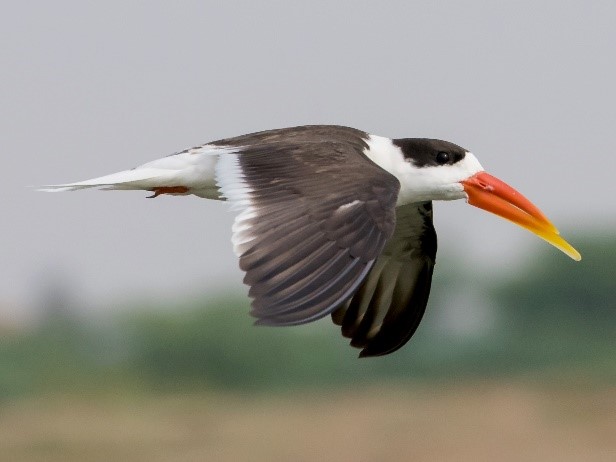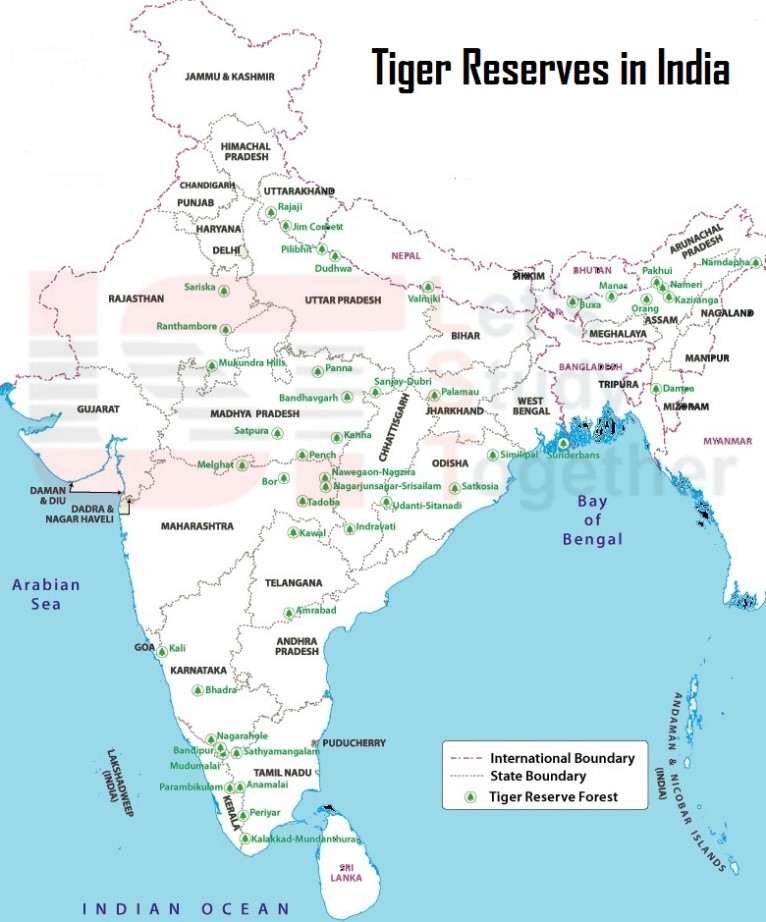Description

Disclaimer: Copyright infringement not intended.
Context
- The endangered Indian Skimmer was spotted along the Ghaghra river at Dudhwa Tiger Reserve.
Indian skimmer
About
- The Indian skimmer or Indian scissors-bill (Rynchops albicollis) is one of the three species that belong to the skimmer genus Rynchops in the family Laridae.
Distribution:
- It is found in southern Asia, where it is patchily distributed and declining in numbers.
- More widespread in winter, the Indian skimmer is found in the coastal estuaries of western and eastern India.
- It occurs primarily on larger, sandy, lowland rivers, around lakes and adjacent marshes and, in the non-breeding season, in estuaries and coasts.
Characteristics, Habitat and Behaviour:
- The Indian skimmer grows to a length of 40-43 cm.
- It has black upper parts, white forehead, collar and lower parts, long, thick, deep orange bill with a yellow tip and longer lower mandible. In flight, it has a white trailing-edge to wing and a short-forked tail with blackish central feathers.
- Nonbreeders are duller and have browner upper parts. Juveniles have a dusky orange bill with a blackish tip, paler brownish-grey crown and nape with dark mottling and paler, more brownish-grey mantle and whitish to pale buff fringing scapulars and wing coverts.
- It breeds colonially on large, exposed sand-bars and islands. Colonies of mating pairs can be observed nesting on sandy islands or open sand banks, often accompanied by other birds like Terns during the breeding season, between February and May.
- It feeds on surface-dwelling fish, small crustaceans and insect larvae. It emits a nasal kap or kip notes, particularly in flight and when disturbed.
Conservation Status:
- IUCN : Endangered
- CITES : Not listed
- The Wildlife Protection Act (WPA) of 1972: Schedule I
Major Threats:
- Habitat degradation: Exploitation and degradation of rivers and lakes through fishing, transportation, domestic use, irrigation schemes and pollution from agricultural and industrial chemicals are largely responsible for the decline of this species as these factors have reduced reproductive and foraging success.
- Excessive and widespread increases in disturbance: The damming of the Chambal River, in upstream Rajasthan, has adversely affected its population at National Chambal Sanctuary, Uttar Pradesh, due to the dropping water levels allowing predators and livestock access to breeding islands (Sundar, 2004).
- Predation by corvids like House crows (Corvus splendens), presence of stray and domestic dogs, have been known to decimate breeding colonies (Siddiqui et al., 2007).

Trivia: The Wildlife Protection Act (WPA) of 1972
- The Wildlife Protection Act (WPA) of 1972is divided into six schedule lists that provide varying degrees of protection. Poaching, smuggling, and illegal trade in animals listed in Schedules 1–4 is all prohibited. Animals included in the Schedule are completely protected from hunting, and trade and commerce involving such animals is strictly regulated.
- The WPA, 1972 governs wildlife conservation and protection in India. India is the first country in the world to include measures for environmental preservation and conservation in its constitution.
- The British Indian Government passed the first such law, the Wild Birds Protection Act, 1887.
Schedules in WPA-1972
Schedule I
- This Schedule deals with endangered species.
- Because these species require strict protection, the greatest punishments for law violations are listed in this Schedule.
- Species listed in this Schedule are forbidden from being hunted in India, unless they pose a threat to human life.
- Species on this list have absolute protection.
- It is illegal to trade these animals.
- Tiger, blackbuck, Himalayan Brown Bear, Brow-Antlered Deer, Blue whale, Common Dolphin, Cheetah, Clouded Leopard, hornbills, Indian Gazelle, and other animals are examples.
Schedule II
- Animals on this list are also afforded high protection, with trade prohibited.
- They cannot be hunted unless there is a threat to human life or they are suffering from a disease/disorder that is beyond recovery.
- Schedule II animals include the Assamese Macaque, Pig Tailed Macaque, Stump Tailed Macaque, Bengal Hanuman langur, Himalayan Black Bear, Himalayan Newt/ Salamander, Jackal, Flying Squirrel, Giant Squirrel, Sperm Whale, Indian Cobra, and King Cobra.
Schedule 3 and Schedule 4 of WPA 1972
- Schedules III and IV contain non-endangered species.
- This includes protected species where hunting is prohibited, but the penalty for any violation is less severe than in the first two schedules.
- Schedule III animals include – Chital (spotted deer), Bharal (blue sheep), Hyena, Nilgai, Sambhar (deer), Sponges
- Schedule IV animals include – Flamingos, Hares, Falcons, Kingfishers, Magpies, Horseshoe Crabs
Schedule 5 of WPA 1972
- Schedule 5 animals are referred to as “vermin” and can be hunted.
- Schedule 5 includes only four animals: mice, rats, common crows, and flying foxes (fruit eating bats).
Schedule 6 of WPA 1972
- It regulates the cultivation of a specific plant and restricts its possession, sale, and transportation.
- Plant cultivation and trade are only permitted with the prior approval of a competent authority.
- Schedule VI plants include the:
- Beddomes’ cycad (Native to India)
- Blue Vanda (Blue Orchid)
- Red Vanda (Red Orchid)
- Kuth (Saussurea lappa)
- Slipper orchids (Paphiopedilum spp.)
- Pitcher plant (Nepenthes khasiana)
Schedule I and II – these are the most vital sections of the act.
- This section covers animals which are in the category of endangered species.
- The sections in this schedule give absolute protection to certain species and these cannot be infringed on any account.
- The animals can only be hunted if they are dangerous to human or diseased or disabled.
- Any violation is a punishable offence, the famous actor Salman Khan was sentenced to 5 years rigorous imprisonment for shooting a black buck in Rajasthan.
- The case is under appeal in the high court. In addition, 16 persons have been convicted and sentenced to various terms of prison up to 7 years for killing a tiger.
.jpg)
Schedule III and IV.
- These also have roughly the same provisions of Section I and II, but cover animals that are not in danger of becoming extinct or endangered, required equal protection.
- The penalties under this section are also less than Schedule I and II.
Schedule V
- This include the list of vermin animals-mice, common crow, monkey, pigs, bats, etc
- For this purpose, the hunter has to apply for a license to the District Forest Officer who will allow a hunter to shoot during a specific season and restricted area. Any infringement can lead to cancellation of the hunting license.
Schedule VI
- It concerns with the cultivation and plant life and gives teeth to setting up more protected animal parks.
|
What are Vermins?
- Vermin means wild mammals and birds which are harmful to crops, farm animals or which carry disease.
- In India, wild animals can be declared as vermin if they have become (i) dangerous to human life or property (including standing crops on any land). (ii) become disabled or diseased as to be beyond recovery.
- The Central Government through notification may declare any wild animal other than those specified in Schedule I and part 11 of Schedule H of the law to be vermin for any area for a given period of time.
- The hunted wildlife is declared as government property and it imposes restrictions on how these carcasses must be disposed of.
- Currently, some animals like the common crow, fruit bats, mice and rats have been listed as vermin in Schedule V of WPA.
- The Union Ministry of Environment, Forest and Climate Change (MoEFCC) has declared Wild Pig as vermin in Uttarakhand and the Monkey as Vermin in Himachal Pradesh for the period of one year for a year.
|
Dudhwa Tiger Reserve
- The Dudhwa Tiger Reserve is a protected area in Uttar Pradesh that stretches mainly across the Lakhimpur Kheri and Bahraich districts.
- It comprises the Dudhwa National Park, Kishanpur Wildlife Sanctuary and Katarniaghat Wildlife Sanctuary.
- It shares the north-eastern boundary with Nepal, which is defined to a large extent by the Mohana River.
- It ranges in altitude from 110 to 185 m and several streams flow through the reserve from the northwest across the alluvial plain that encompasses the reserve.
- The Dudhwa National Park and the Kishanpur Wildlife Sanctuary were designated as Dudhwa Tiger Reserve in 1987 as part of Project Tiger. The Katarniaghat Wildlife Sanctuary was added in the year 2000.

READ ABOUT GHAGGAR RIVER: https://www.iasgyan.in/daily-current-affairs/pollution-in-ghaggar-river
|
PRACTICE QUESTION
Q. Consider the following statements.
1.Dudhwa Tiger Reserve shares the north-eastern boundary with Nepal.
2.Schedule 5 of the Wildlife Protection Act (WPA) of 1972 regulates the cultivation of a specific plant and restricts its possession, sale, and transportation.
3.The Indian skimmer is a Critically Endangered bird found in Southern Asia.
How many of the above are correct?
A) Only 1
B) Only 2
C) Only 3
D) All Four
Answer: A) Only 1
|
https://www.thehindu.com/news/national/army-likely-to-complete-inducting-114-dhanush-guns-by-2026/article67317964.ece











